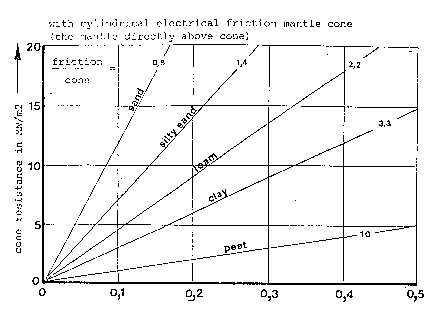To carry out a geotechnical analysis, knowledge of the condition of the soil composition is essential. The quality of the soil composition determines the behavior of the foundation structure. For this purpose a number of technical tools are available.
A well-known applied technical tool is the analysis based on the measured cone resistance and/or cone resistance in combination with friction resistance.

In the NEN-EN 1997-1 Table 2.b shows cone resistances which can determine the type of soil. Based on these figures analysis criteria are formulated in the basic package.
With some of the CPT's simultaneous measurements are taken of the cone tip resistance (qc) and the local sleeve friction (fs). The cone tip resistance, qc, is defined as the total force acting on the cone tip. Fc, is divided by the cross-sectional area of the base of the cone Ab, and is usually expressed in units of MPa. The sleeve friction, fs , is defined as the total force on the friction sleeve. Fs is divided by the surface area of the sleeve As and is usually expressed in units of MPa.

The relation between the fs and qc at an arbitrary depth, is called the friction ratio (Rf %). Soil classification of the subsurface profile is achieved by means of the friction ratio Rf. It suggests the use of a statistically based technique, known as the cross-correlation function. With this function the parameter can be estimated more accurately. CPT's of which friction values can be calculated generally provide more information about the structure of the soil condition than CPT's in which only the cone resistance is determined. In the figure below the relation is shown between the friction ratio and the soil material type of the electrical CPT.

Based on the figure above analysis criteria are formulated for soil materials (the formulation is based on the NEN-EN 1997-1). If desired, users can modify these criteria in the basic package.